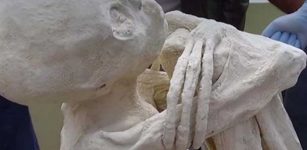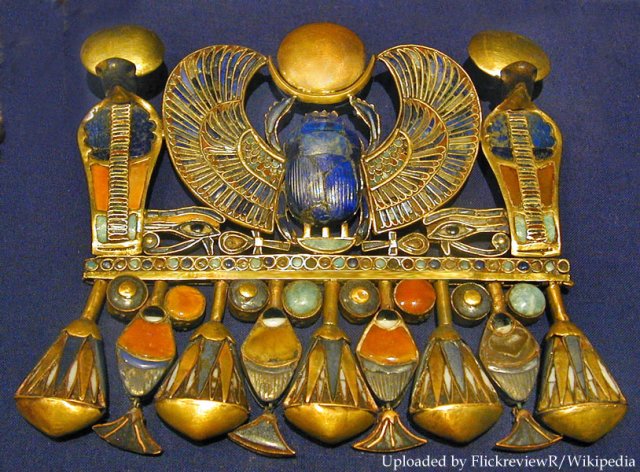Secrets Of The Scarab – Ancient Sacred Symbol In Human History
A. Sutherland - AncientPages.com - Ornaments in the shape of beetles are known from the late Paleolithic epoch (10,000 to 20,000 years ago). However, so much earlier than the Egyptian civilization, it is difficult to know the exact meaning these people attributed to beetle body ornaments.
Statue of Khepri, the sacred scarab in Karnak Temple Complex Luxor. Credit: Adobe Stock - Mountains Hunter
Scarab is one of the ancient Egyptians' oldest and most widely used symbols. Egyptian pharaohs worshipped dung beetles; most probably, it was symbolically as sacred to the Egyptians as the cross is to Christians.
The scarabs with aesthetic qualities and shamanic symbolism were already known in the Old Kingdom (3rd millennium BC) and played an important role in the early worship of animals. It is supported by archaeological evidence discovered in graves during the time of King Den of Dynasty I.
Sir W. M. Flinders Petrie, in Scarabs and cylinders with names, writes that many different kinds of beetle were sacred and venerated in ancient Egypt. Evidence of this can be seen on many jars, found in graves containing numerous dried beetles, both large and small, and many amulets, especially in the form of large sacred Scarabeus sacer.
Particularly well-known is an amulet depicting 'the sun - the big ball rolled across the heaven by the Creator, and the scarab is an emblem of the Creator, Khepera...' or the sun god Khepri (Kheper (a), in the mythology of ancient Egypt, 'the Father of the Gods' and this symbolism of the beetle is a part of the primeval animal worship of ancient Egypt.
The 'Kheper' is 'being' and means existence, creation, or becoming; so, the god Khepera is the self-existent creator god.'
Winged scarab of Tutankhamun with semi-precious stones. This pectoral is composed of Tut's Prenomen name: "NebKheperU-Ra", the hieroglyphs of: Basket, Scarab-(in Plural-strokes), and Re. Credit: Jean-Pierre Dalbéra, Flickr - CC BY 4.0
The scarab was depicted with the disc of Ra in its claws in the 12th, 18th, and later dynasties and associated with other gods as a creative emblem.
Millions of amulets and stamp seals of stone or faience were fashioned in Egypt with depictions of the scarab beetle, and this tradition survived well beyond the dynastic periods.
'On the passing to the 23rd dynasty and later the winged scarab was placed on the breast of the mummies, as the emblem of the Creator, who will transform the dead, and from the 26th to the 30th dynasties, many scarabs were placed on the mummy, usually a row of half a dozen or more along with the figures of the gods.' (W.M.F.Petrie)
Ornament from an ancient Egyptian sarcophagus with Scarab Beetle. Credit: Adobe Stock - Juulijs
In Roman times, there were various kinds of beetles and the Greeks adopted the carved stone columns, which seems to confirm the importance of the sacred temples of the Egyptian scarabs:
"I am Cheprer, a student, and when I spread wings, back to life."
The sacred 'Chilam Balam' books written by the Maya describe the scarab as a dirt ground, in terms of material and moral, which is destined to become a saint, and in China, we find the same symbolic interpretation in 'the scarab rolls its ball, which is called by life.'
'The scarabaeus rolls his ball and in the ball there develops life as the result of the undivided effort of his spiritual concentration. If now an embryo can grow in manure and shed its shells, why then should not the dwelling place of our heavenly heart also be able to create a body if we concentrate the spirit upon it..? we read in the 'The Secret of the Golden Flower" - A Chinese Book of Life, translated in 1931).
The famous text of “The Secret of the Golden Flower,” takes the sacred scarab as an example of the “work to be done” to reach spiritual immortality, either material (for the body), or spiritual (for the soul).
This is a giant sculpture of a scarab beetle. It is around one and a half meters long and is one of the largest known representations of a scarab beetle. This scarab is thought to be from the Ptolemaic period (305-30 BC) but could be earlier. It may once have stood in an Egyptian temple but it was found in Constantinople (modern Istanbul) in Turkey. It may have been taken from Egypt to Constantinople when the city became the capital of the Later Roman Empire in AD 330. Image credit: British Museum.
It is a goal of the Taoism philosophy, which believes in the strengths of various material “pellets” that aid in reaching immortality.
The scarab dung ball was identified as one of these important 'pellet substances'.
Many beetle species have been and still are used as food in America, Australasia, Asia, and Africa; some were also eaten in Europe. Through Art Nouveau jewelry of the 1900s, Western civilization was richly adorned with beetles and other insects.
In Europe and North America, collars, broaches, and ear pendants used beetles mounted on bronze. Today, especially in Mexico, living specimens of some beetle species are worn by women as broaches, attached with a small gold or bronze chain.
By the way, some say that the scarab worn as a pendant around the neck can cause disease of the throat and larynx. Or is it only an illusion...?
Updated on February 23, 2024
Written by A. Sutherland - AncientPages.com Senior Staff Writer
Copyright © AncientPages.com All rights reserved. This material may not be published, broadcast, rewritten or redistributed in whole or part without the express written permission of AncientPages.com
Expand for referencesReferences:
Myer, I. Scarabs The History, Manufacture and Symbolism of the Scarabæus
in Ancient Egypt, Phoenicia, Sardinia, Etruria, etc.
More From Ancient Pages
-
 Echo And Narcissus: Cursed Ability To Speak And Punishment Of Selfish Love And Vanity
Featured Stories | Feb 9, 2021
Echo And Narcissus: Cursed Ability To Speak And Punishment Of Selfish Love And Vanity
Featured Stories | Feb 9, 2021 -
 16 Dead Sea Scrolls Fragments Are Forgeries – U.S. Bible Museum Says
Artifacts | Mar 15, 2020
16 Dead Sea Scrolls Fragments Are Forgeries – U.S. Bible Museum Says
Artifacts | Mar 15, 2020 -
 82 Mysterious 3,000-Year-Old Pits Discovered In Sweden – Bronze Age Cooking Pits And Ancient Ceremonial Center?
Archaeology | Jun 13, 2017
82 Mysterious 3,000-Year-Old Pits Discovered In Sweden – Bronze Age Cooking Pits And Ancient Ceremonial Center?
Archaeology | Jun 13, 2017 -
 Face Of Queen Lady Cao Reconstructed – Unique Look At The First Known Female Ruler In Peru
Archaeology | Jul 10, 2017
Face Of Queen Lady Cao Reconstructed – Unique Look At The First Known Female Ruler In Peru
Archaeology | Jul 10, 2017 -
 Uruk Was Ruled By Gilgamesh Who Built City’s Great Walls
Featured Stories | Jul 26, 2016
Uruk Was Ruled By Gilgamesh Who Built City’s Great Walls
Featured Stories | Jul 26, 2016 -
 Graffiti Reveals Crusaders’ Beautiful Altar In The Church Of The Holy Sepulchre
Archaeology | Jul 24, 2024
Graffiti Reveals Crusaders’ Beautiful Altar In The Church Of The Holy Sepulchre
Archaeology | Jul 24, 2024 -
 Cosmic Rays Reveal Mysterious Void Inside Great Pyramid – What’s Hiding Inside?
Archaeology | Nov 2, 2017
Cosmic Rays Reveal Mysterious Void Inside Great Pyramid – What’s Hiding Inside?
Archaeology | Nov 2, 2017 -
 Rare Unexpected Discovery Of Elizabethan-Era Ship At Quarry 300 Meters From The Coast
Archaeology | Jan 2, 2023
Rare Unexpected Discovery Of Elizabethan-Era Ship At Quarry 300 Meters From The Coast
Archaeology | Jan 2, 2023 -
 2,000-Year-Old Fountain In Kibyra, The City Of Gladiators Flows Again
Archaeology | Jan 3, 2023
2,000-Year-Old Fountain In Kibyra, The City Of Gladiators Flows Again
Archaeology | Jan 3, 2023 -
 7,000-Year-Old Ibex Remains Found Under The Ice In Italy Are 1,700 Years Older Than Ötzi!
Archaeology | Dec 14, 2022
7,000-Year-Old Ibex Remains Found Under The Ice In Italy Are 1,700 Years Older Than Ötzi!
Archaeology | Dec 14, 2022 -
 Lamashtu Plaque: Assyrian Healing Device Against The Evil Goddess
Artifacts | Mar 16, 2023
Lamashtu Plaque: Assyrian Healing Device Against The Evil Goddess
Artifacts | Mar 16, 2023 -
 Old Norse Settlers Traded Walrus Ivory With Kyiv – Spectacular Archaeological Finds Reveal
Archaeology | Jun 16, 2022
Old Norse Settlers Traded Walrus Ivory With Kyiv – Spectacular Archaeological Finds Reveal
Archaeology | Jun 16, 2022 -
 Crimean Atlantis: Remarkable Ancient Underwater City Of Akra
Featured Stories | Mar 6, 2017
Crimean Atlantis: Remarkable Ancient Underwater City Of Akra
Featured Stories | Mar 6, 2017 -
 Archaeologists Shed Light On The Lives Of Stone Age Hunter-Gatherers In Britain
Archaeology | Jan 20, 2023
Archaeologists Shed Light On The Lives Of Stone Age Hunter-Gatherers In Britain
Archaeology | Jan 20, 2023 -
 Surprising Discovery Of Ancient Silver Coin Depicting Viking King Harald Hardrada In Hungary
Archaeology | Jun 20, 2022
Surprising Discovery Of Ancient Silver Coin Depicting Viking King Harald Hardrada In Hungary
Archaeology | Jun 20, 2022 -
 Seven 1,600-Year-Old Arjai Grottoes With Frescoes – Restored
Archaeology | Jul 11, 2020
Seven 1,600-Year-Old Arjai Grottoes With Frescoes – Restored
Archaeology | Jul 11, 2020 -
 Hidden Ancient Underground Tomb Discovered In Petra May Solve The Mystery Of The Nabataean Kingdom
Places | Oct 18, 2024
Hidden Ancient Underground Tomb Discovered In Petra May Solve The Mystery Of The Nabataean Kingdom
Places | Oct 18, 2024 -
 How Sæmundur The Wise Tricked The Devil Three Times
Featured Stories | Jun 8, 2020
How Sæmundur The Wise Tricked The Devil Three Times
Featured Stories | Jun 8, 2020 -
 Mystery Of Nazca’s Controversial Three-Fingered Mummies Continues – Attempt To Confiscate The Ancient Remains!
Archaeology | Oct 26, 2019
Mystery Of Nazca’s Controversial Three-Fingered Mummies Continues – Attempt To Confiscate The Ancient Remains!
Archaeology | Oct 26, 2019 -
 A Sensational Bronze Age Grave Of 20-Year-Old Elite Woman Found In Town Of Mány, Hungary
Archaeology | Aug 8, 2022
A Sensational Bronze Age Grave Of 20-Year-Old Elite Woman Found In Town Of Mány, Hungary
Archaeology | Aug 8, 2022




